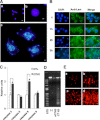β-Actin-binding complementarity-determining region 2 of variable heavy chain from monoclonal antibody C7 induces apoptosis in several human tumor cells and is protective against metastatic melanoma
- PMID: 22334655
- PMCID: PMC3340220
- DOI: 10.1074/jbc.M111.322362
β-Actin-binding complementarity-determining region 2 of variable heavy chain from monoclonal antibody C7 induces apoptosis in several human tumor cells and is protective against metastatic melanoma
Abstract
Complementarity-determining regions (CDRs) from monoclonal antibodies tested as synthetic peptides display anti-infective and antitumor activities, independent of the specificity of the native antibody. Previously, we have shown that the synthetic peptide C7H2, based on the heavy chain CDR 2 from monoclonal antibody C7, a mAb directed to a mannoprotein of Candida albicans, significantly reduced B16F10 melanoma growth and lung colony formation by triggering tumor apoptosis. The mechanism, however, by which C7H2 induced apoptosis in tumor cells remained unknown. Here, we demonstrate that C7H2 interacts with components of the tumor cells cytoskeleton, being rapidly internalized after binding to the tumor cell surface. Mass spectrometry analysis and in vitro validation revealed that β-actin is the receptor of C7H2 in the tumor cells. C7H2 induces β-actin polymerization and F-actin stabilization, linked with abundant generation of superoxide anions and apoptosis. Major phenotypes following peptide binding were chromatin condensation, DNA fragmentation, annexin V binding, lamin disruption, caspase 8 and 3 activation, and organelle alterations. Finally, we evaluated the cytotoxic efficacy of C7H2 in a panel of human tumor cell lines. All tumor cell lines studied were equally susceptible to C7H2 in vitro. The C7H2 amide without further derivatization significantly reduced lung metastasis of mice endovenously challenged with B16F10-Nex2 melanoma cells. No significant cytotoxicity was observed toward nontumorigenic cell lines on short incubation in vitro or in naïve mice injected with a high dose of the peptide. We believe that C7H2 is a promising peptide to be developed as an anticancer drug.
Figures





References
-
- Bhutia S. K., Maiti T. K. (2008) Targeting tumors with peptides from natural sources. Trends Biotechnol. 26, 210–217 - PubMed
-
- Daffre S., Bulet P., Spisni A., Ehret-Sabatier L., Rodrigues E. G., Travassos L. R. (2008) in Studies in Natural Products Chemistry (Atta-urRahman, ed) pp. 597–691, Elsevier, The Netherlands
-
- Janin Y. L. (2003) Peptides with anticancer use or potential. Amino Acids 25, 1–40 - PubMed
-
- Magliani W., Conti S., Salati A., Arseni S., Ravanetti L., Frazzi R., Polonelli L. (2004) Engineered killer mimotopes: new synthetic peptides for antimicrobial therapy. Curr. Med. Chem. 11, 1793–1800 - PubMed
Publication types
MeSH terms
Substances
LinkOut - more resources
Full Text Sources
Other Literature Sources
Medical
Research Materials
Miscellaneous

